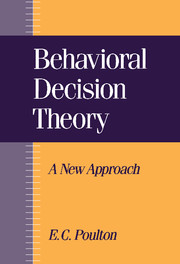Book contents
- Frontmatter
- Acknowledgments
- Contents
- Preface
- Chapter 1 Outline of heuristics and biases
- Chapter 2 Practical techniques
- Chapter 3 Apparent overconfidence
- Chapter 4 Hindsight bias
- Chapter 5 Small sample fallacy
- Chapter 6 Conjunction fallacy
- Chapter 7 Regression fallacy
- Chapter 8 Base rate neglect
- Chapter 9 Availability and simulation fallacies
- Chapter 10 Anchoring and adjustment biases
- Chapter 11 Expected utility fallacy
- Chapter 12 Bias by frames
- Chapter 13 Simple biases accompanying complex biases
- Chapter 14 Problem questions
- Chapter 15 Training
- Chapter 16 Overview
- References
- Index
Chapter 4 - Hindsight bias
Published online by Cambridge University Press: 06 July 2010
- Frontmatter
- Acknowledgments
- Contents
- Preface
- Chapter 1 Outline of heuristics and biases
- Chapter 2 Practical techniques
- Chapter 3 Apparent overconfidence
- Chapter 4 Hindsight bias
- Chapter 5 Small sample fallacy
- Chapter 6 Conjunction fallacy
- Chapter 7 Regression fallacy
- Chapter 8 Base rate neglect
- Chapter 9 Availability and simulation fallacies
- Chapter 10 Anchoring and adjustment biases
- Chapter 11 Expected utility fallacy
- Chapter 12 Bias by frames
- Chapter 13 Simple biases accompanying complex biases
- Chapter 14 Problem questions
- Chapter 15 Training
- Chapter 16 Overview
- References
- Index
Summary
Summary
Hindsight changes the relative importance of the influences that are judged to be responsible for an event in directions that make them more compatible with the known outcome. Knowing the first result of a novel experiment makes identical subsequent results appear more likely, and so belittles the outcome of the investigation.
The retroactive interference produced by hindsight can bias the memory of a forecast. But the response contraction bias can have as great or a greater influence on the reported memory than does hindsight. There is also a reverse effect that corresponds to proactive interference: memory of a forecast can reduce hindsight bias. The reduction can be produced indirectly by asking for a reason at the time of the forecast to strengthen the memory of the forecast. The reduction can also be produced directly at the time of recall by asking for a reason, or simply by giving a warning that a reason will have to be given. The writing of history, forecasting, and replicating experimental results, are all likely to be affected by hindsight.
Relations between foresight and hindsight
The flow chart of Figure 4.1 shows the time sequence in a full investigation of hindsight bias. A forecast is made before an event occurs. The forecaster remembers part or all of the forecast. Then comes the outcome, which produces hindsight. The arrows and paths at the sides of the figure illustrate ways in which hindsight and foresight are related to each other.
- Type
- Chapter
- Information
- Behavioral Decision TheoryA New Approach, pp. 62 - 77Publisher: Cambridge University PressPrint publication year: 1994

